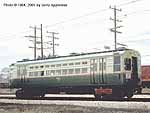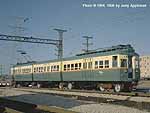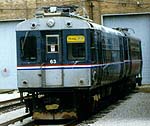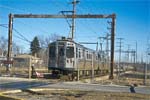The recent purchase of the St. Petersburg 2000-series cars has left me a little low on funds for the month and, as such, I have refrained from spending money on any of my projects. (More delays...)
I have, however, been pushing forward with work on the 3200-series cars. (The best part is that it doesn't cost a dime.) Taking a page from CTA O Scale L Layout I've been doing some 3D modeling with the intent of having them 3D printed by Shapeways. While the 3200s generally look good, MTH made some rather glaring (to my eyes) errors with these cars and I intend to fix as many of them as I can. Some changes I intend to make are to modify the cars with appropriate Skokie equipment and 3D printing should work nicely for all aspects.
One of the first things I'm going to tackle are the snowplows. As seen in the photo, the cars as built come equipped with snowplows. They actually don't look terrible, but they do have drawbacks. For starters, the snowplow is mounted to the truck instead of the car body. This was done to accommodate the tight turns the cars are built for (they're tighter than the 90-foot radius curves the prototype can take). Also they've got to be able to work with the gargantuan knuckle coupler that the cars are fitted with. Convinced that I could do a decent job, I took some measurements from the preserved 2200-series cars at the Illinois Railway Museum on a recent trip with my father.
This was the result. I think it looks pretty good. Better, in fact, than I had anticipated and so I started adding details I hadn't originally planned on. This, unfortunately, left me with a few missing dimensions that I'll have to get on my next trip out there.
The vertical and angled pieces are actually "L" shaped on the prototype. I haven't attempted to duplicate that in the 3D model for strength concerns on the printed product. If everything goes well, I may try to fix this. What had been designed is just the frame. The snowplow blades themselves will actually be two pieces of cut card stock which will be glued to the frame and then a strip of styrene (or a 3D printed piece) will go over the front. Once painted it should look pretty close this.
Another thing I've been working on are the seats. Just about everything under the floor of the car is wrong (the third rail equipment is actually really good aside from the fact that both trucks have provision for sleet scrapers) so my plan is to replace all of it. The model is equipped with seats in a pretty accurate arrangement, however, this is what they look like.
Doesn't seem like it could be possible, but they're worse than the seats in the bowling alleys! Since they're attached to the floor, they'll get replaced when everything else does.
I think what I've come up with looks pretty good, however, I'm not totally satisfied. I think the angle of the back is a little too shallow (I eyeballed it). The next time I'm on the "L" I'll have to take a protractor out and get the exact angle. Work continues!

















